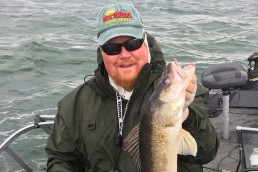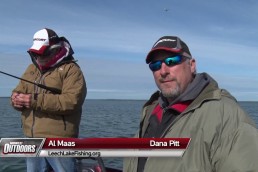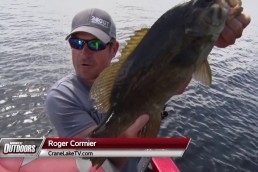Get Ready for the Opener on Leech Lake
SHARE THIS POST
The average ice-out date for Leech Lake is April 27, but there are 51 days between the earliest and the latest ice-out dates on record for Leech, so the timing can vary greatly from year to year.
The Minnesota walleye opener is set for Saturday, May 14, which is the latest date possible because the season opens on the second Saturday in May each year. So there will be at least a couple weeks of open water on Leech Lake before the walleye season. If the mild winter is an indication of what will happen this spring, there could be an early ice-out followed by a late opener.
The sequence of events is basically the same each spring. The biggest difference is the timeframe when everything happens and whether it is an early or late spring.
Water temperatures are the biggest factor in determining when things happen. Surface water temperatures are most accurately taken first thing in the morning, before the sun starts warming the water.
The water temperatures spike during the day, but the critical measurement is how much heat the water can hold overnight.
Walleyes, perch and northern pike spawn while water temperatures are in the mid-40s. Largemouth bass, smallmouths, crappies, sunfish and muskies spawn later in spring, when water temperatures hit the mid-60s.
An early spring will mean the walleyes will be further along in their post-spawn migrations when the season opens, while a colder spring would produce the opposite results.
This always sounds good in theory, but anyone who has lived through their share of Minnesota springs realize that everything can be going along great and then a protracted cold front arrives that refuses to leave.
If the water temperatures stop rising and begin to fall before or during the spawn, everything stops in its tracks. The spawn won’t resume again until the water temperatures recover to the same point and rise again.
Northern pike start to enter the shallows and backwaters before all the ice is off the main lake. Pike will run up anything with current, looking for some little calm, protected area where they can spawn. Pike often spawn at night, with one or more smaller males surrounding the larger females, and this fish is capable of spawning in something as small as a ditch and or in flooded backwaters where their young may get landlocked as water levels recede.
Perch are another early-spawning species, with the perch laying their eggs in strands on the old stalks and stems of last year’s standing weeds and also in old hard-stemmed reed beds. Perch usually prefer the deeper patches of weeds to the ones in shallower water.
Anglers have a short window of opportunity after ice-out for perch in spawning areas. The male perch show up first and stay last, with the females showing up right before they are ready to spawn then leaving right after they finish.
River-spawning walleyes split into multiple groups in the spring, with fish running up different rivers or streams or moving through a chain of lakes to reach some fast-water section of river to spawn. Another group of walleyes in most lakes stay within the boundaries of the lake and spawn on shoreline or mid-lake areas with the right mixture of bottom content, depth and wave action.
All spawning walleyes look for similar areas of broken rock and gravel to lay eggs. The river-spawning walleyes incubate their eggs with current, while ones in lakes use a wave action to accomplish their results.
Are you enjoying this post?
You can be among the first to get the latest info on where to go, what to use and how to use it!
The best thing anglers can do in preparation for the walleye opener on Leech Lake would be to track when the ice goes out and plot the progress of the water temperatures. They will spawn between 44 and 48 degrees in both the lakes and the rivers, with the river-spawning walleyes usually a week to 10 days ahead of the fish that stay in the lake.
Female walleyes take longer to recover after the spawn than male walleyes. Anglers can usually start catching males within days after spawning, while females can take more than a week to recover before resuming normal feeding patterns. Males will start getting active when the water temperatures reach the upper 40s, while females usually take until water temperatures rise into the mid-50s before getting active.
Post-spawn walleyes are looking for the “easy button” in the spring, whether it’s small perch or spottail shiner minnows coming into the shallows to spawn. And there is very little cover for baitfish early in the season, so areas with new weed growth or rocks and gravel are usually ideal for the feeding walleyes.
Once recovered from the spawn, the females show up hungry and ready to feed on Leech Lake, with the big ones showing up on the windward sides of points and shoreline structures holding the most baitfish.
The more time that passes after the walleyes finish spawning, the more fully dispersed back into the lake they will be when the season opens.
Many walleyes spawn in the rivers at the north ends of the bays. Once they do, they work their way down the bay toward their early-summer locations.
Presentations for walleyes early in the season include jigs, slip bobbers and slow-trolling minnow baits after dark. I am a big fan of jigs, so I will rig my St. Croix Legend walleye rods with 10- or 12-pound-test Sunline SX 1 braid, then use a tiny swivel to attach 12 to 18 inches of 8-pound-test clear Sunline FC fluorocarbon leader. This allows you to feel your jig even in windy conditions.
I use Northland Fireball Jigs with the short shank when I want to fish walleyes in the rocks. I will use a light jig, usually 1/16 or 1/8 ounce, to keep bottom contact to a minimum to help avoid getting snagged.
I prefer the Northland RZ Jig with the longer shank in 3/16 or 1/4 ounce when fishing through new weed growth so I can double-hook a shiner minnow to help make it more weedless; I prefer a heavier jig so I can give the jig plenty of action and still keep it close to the bottom.
Shiners are excellent bait, but if you can’t find them, rainbow chubs and fatheads will also work. To keep my minnows lively, I rely on a Frabill Bait station with a bubbler.
I like to make a trip or two out on Leech Lake before the walleye season opens so I can look for new weeds and also check the water temperatures and maybe graph a few fish. My favorite tool for that is a Humminbird Helix 10.
And I also like to check on the crappies and the bluegills on Leech Lake early in the season, or head for the Rainy River for sturgeon while I wait for the walleye season to open.
Brian “Bro” Brosdahl is a nationally known fishing guide and lead spokesman for many of the top companies in ice fishing. He can be contacted at bbro@paulbunyan.net or through his website at brosguideservice.com. Follow him on Instagram, Twitter and Facebook.
MWO
SHARE THIS POST
Did you enjoy this post?
You can be among the first to get the latest info on where to go, what to use and how to use it!
Brian 'Bro' Brosdahl
Outdoor communicator Brian “Bro” Brosdahl lives in northern Minnesota. He is a walleye guide in the Cass Lake, Leech Lake and Lake Winnibigoshish areas. He is sponsored by Northland Fishing Tackle, Frabill/Plano, Aqua-Vu, Humminbird/Minn Kota, St. Croix Rods, Ranger Boats, and Evinrude. Guide inquiries: brosguideservice.com. Follow on social media.



